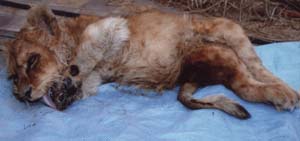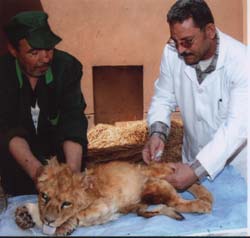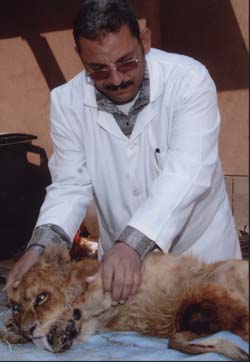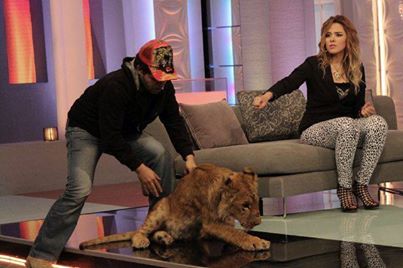AWAR AWARENESS– WILDLIFE UNIT
Why individual wild animals shouldn't be exploited as photographic props?
In most cases, animals used as photo props have been removed from their mothers at a very early age. Large animals such as big cats may be drugged with sedatives to make them more docile and weak.
Young animals such as baby monkeys, may be given amphetamines to keep them awake especially to be paraded around bars and restaurants at night.
The real price of your souvenir photographs:
Baby animals torn from their mothers, broken teeth, clipped out claws, drugging and beatings…. A life time of suffering
It is not uncommon to see animals used as 'photo props' being roughly handled and even beaten to make them pause for the camera.
Confining wild animals with ropes and chains, forcing them to interact with humans, is totally against their instincts and incredibly stressful.
Photography animals are often used for hours on end, with a little respite from the stress.
Animals used for photography sessions, particularly carnivores (such as big cats) and primates (such as gibbons, monkey and lonses) may have their teeth pulled out or crudely broken and blunted, often without anaesthetic, to make them "safer'.
Big cats may have their claws torn out with no pain relief.
When visiting animal facilities:
How close should we get?
It is everyone's responsibility to ensure the following is met:
1. If you are sick do not enter or get close to any animal exhibition
2. Do not spit or nose blow on the ground. Suppress sneezes and coughs.
3. Never feed wildlife
4. Use the latrine and wash hands with soap before entering any animal facility and upon return
5. Littering of any kind is forbidden except in designated waste cans.
Beware of the serious animal welfare implications or the risks to public health and safety.
The risk to public safety
There have been numerous recorded incidents of direct contact activities with humans that have resulted in injury or even death
The transmission of diseases from animals to human
Direct animal/human contact should be avoided and where it does occur, it must be for limited periods of time, making sure welfare of the animal(s) is not jeopardized. Any animal contact must be continuously supervised and tourists should be made aware of the risks.
A few of the most persistent human pathogens capable of infecting chimpanzees and other primates. Coxsackie virus, Herpes Simplex 1&2 , Orthomyxovirus, Parainfluenza (type 3) Paramyxovirus, Poliovirus, Respiratory Syncitial virus, Mycobacterium tuberculosis, Sarcoptes scabies, Giardia lamblia
Source: the Jane Goodall Institute
Many diseases can be transmitted from animals to humans. There is a wealth of evidence to suggest that direct contact with animals poses a significant risk of zoonotic disease transmission which may result in serious illness or even death. The increasing trend for animal attractions to encourage more ‘hands on’ encounters with animals therefore presents a very real threat to public safety. Despite this, many animal attractions are seemingly unaware of or fail to publicize the risks, and they do little to implement preventative measures to minimize disease transmission.
Request for action to end this animal abuse
Code of Practice for Animal Attractions in which the practice of using animals for photographic props is strongly discouraged on animal welfare grounds
All animal welfare societies and groups should encourage people to proved details about the exploitation seen.
Awareness campaigns of the serious animal welfare implications and the risks to public health and safety.
Awareness - Wildlife - AWAR
March 12, 2014 - we name and shame MBC Sat channel, we name and shame Al Nehar, and various channels for promoting a wrong educational message to public derived from total ignorance of laws, health issues and animal rights issues. The picture hereunder is of Lions Trainer Anoussa Kouta, promoting using wild animals in circuses and claiming the cub is like a pet !!!
Today, March 25, 2014 - still we see many happy to upload pictures with lion cubs used as photo props, we continue to campaign and spread messages to raise awareness.
لا تشجعوا جلسات التصوير مع الحيوانات البرية - ذلك ممنوع قانونا اضافة الي: الحيوان الصغير يوءخذ من امه لأجل هذه الجلسات + يحقن غالبا بمخدر و خلافه ليرضخ لطلبات التصوير + الصحة العامة : الأمراض تنتقل من الانسان للحيوان و من الحيوان للانسان - دعنا ننشر التوعية في كل مكان - مش ضروري شرطي ورا كل مواطن علشان نعمل الصح - احنا المفروض يكون عندنا وعي كفاية - أيضا اطلب من الجميع ان يتصرفوا بايجابية و بالابلاغ فورا عن وجود أشبال سباع او غيره في المطاعم او كافيهات او خلافه - هذا ممنوع قانونا - أرقام شرطة البيئة و المسطحات للابلاغ :
25258511
http://www.bornfree.org.uk/campaigns/zoo-check/travellers-animal-alert/photo-props/
Why Should the use of wild animals as photographic props be banned?
Why individual wild animals shouldn't be exploited as photographic props?

One of many cases in hotels, restaurants, zoos and various
On 24/03/2009 compassionate travelers contacted us to inform and provide details about the exploitation they have seen, which spoiled their holiday. A police report was filed (755) and as a result the lion cub was confiscated and delivered to Giza Zoo. The medical examination by Dr. Refaat Abd Elhaseib revealed the intolerable suffering of the lion cub which died as result in less than a week. The real price of souvenir photographs

The medical report: Intolerable abuse
malnourished and close to death
all claws pulled out
front right forelimb broken
fracture spinal column
torsion trachea
internal hemorrhage in chest and abdomen
Beware of the serious animal welfare implications or the risks to public health and safety.
The risk to public safety
There have been numerous recorded incidents of direct contact activities with humans that have resulted in injury or even death
The transmission of diseases from animals to human
Direct animal/human contact should be avoided and where it does occur, it must be for limited periods of time, making sure welfare of the animal(s) is not jeopardized. Any animal contact must be continuously supervised and tourists should be made aware of the risks.
A few of the most persistent human pathogens capable of infecting chimpanzees and other primates. Coxsackie virus, Herpes Simplex 1&2 , Orthomyxovirus, Parainfluenza (type 3) Paramyxovirus, Poliovirus, Respiratory Syncitial virus, Mycobacterium tuberculosis, Sarcoptes scabies, Giardia lamblia
Source: the Jane Goodall Institute
Many diseases can be transmitted from animals to humans. There is a wealth of evidence to suggest that direct contact with animals poses a significant risk of zoonotic disease transmission which may result in serious illness or even death. The increasing trend for animal attractions to encourage more ‘hands on’ encounters with animals therefore presents a very real threat to public safety. Despite this, many animal attractions are seemingly unaware of or fail to publicize the risks, and they do little to implement preventative measures to minimize disease transmission.
Results and conclusions are concise and relate back to objectives.
Request for action to end this animal abuse
Code of Practice for Animal Attractions in which the practice of using animals for photographic props is strongly discouraged on animal welfare grounds
All animal welfare societies and groups should encourage people to proved details about the exploitation seen.
Awareness campaigns of the serious animal welfare implications and the risks to public health and safety.
Wildlife Awareness
Video : campaign to stop using wild animals as photo props
http://www.youtube.com/watch?v=UfOXnYjUFV4
